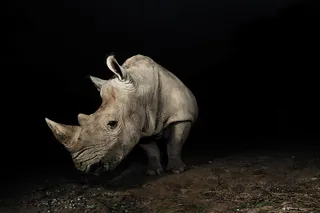
A (t)horny problem
According to Bill Moyes of Aon South Africa’s commercial unit, similarly creative thinking can help insurers and reinsurers become a force for good in the world.
The programme was created through collaboration between Aon, and one of their clients, nature conservationist Peter Milton of the Strategic Protection of Threatened Species (SPOTS). According to Moyes, “In discussions with us Milton said, ‘Is there anything we can do for rhinos?’ I pulled in Peter Darroll, an executive at ONE, and he and I put together this package from an insurance perspective. We found an avenue in the Rhino Rescue Project, and that’s where it all started.”
The Rhino Rescue project was conceptualised and launched by conservationist Lorinda Hern of the Rhino and Lion Nature Reserve and veterinary specialist Dr Charles van Niekerk, and is positioned as an out-of-the-box solution to an out of control problem. The project promotes the treatment of the rhino horn while the animal is under sedation, infusing it with an indelible dye that contaminates the horn. The dye is mixed with a compound of ectoparasiticides which serve to protect the rhino from ticks and other parasites that spread infection. The compound is toxic to humans but completely safe for animals, including ox-peckers and vultures. A full DNA sample is also harvested from the rhino and three matching identification microchips are inserted, one per horn and the third on the animal.
To add leverage to the project, Aon and ONE stepped on board to provide insurance cover to rhino owners, covering all risk of mortality for the animal including during the treatment process, as well as providing cover for poaching once the treatment has been completed and the DNA registered on the database at Onderstepoort. This is crucial in aiding the legal community in securing prosecutions in cases where poached horns are recovered by being able to trace exactly which animal the horn belonged to. The microchips also serve as a means of identification. By law, any rhino that is immobilised for whatever reason now has to be micro-chipped.
“The fact that the rhinos in any reserve are treated is widely publicised by means of signposts around the reserve’s perimeter and, should a treated rhino be killed, the indelible dye is clearly visible inside the horn—a clear indication that the horn had been contaminated. We also strongly suggest involving staff on the reserve and informing them of the horn treatment process as their involvement ensures that word about the treatment spreads rapidly via the bush telegraph,” explained Bill.
“To date, we are providing the only insurance cover currently available for rhino owners against poaching available without additional monthly premium, on condition that the animal undergoes a rhino horn treatment process offered by The Rhino Rescue Project (RRP), which is offered at a one-off cost. Prior to the introduction of this new product solution by ONE and Aon, insurance cover for rhinos specifically covering poaching was exceptionally expensive and in many cases, simply unattainable,” explained Moyes.
Aon South Africa’s annual coverage is available at premiums of 3.5 percent of the value of the animal—rhinos go at auction for anywhere from $25,000 to $100,000—a premium price considered by Moyes to be “very competitive in any language.”
Moyes told Bermuda:Re: “We’ve got a problem in this country, and in Africa in general. Our lions and leopards are being annihilated for their bones. Poaching coverage is not new—you could get it for your rhino before this product, but it was extremely expensive and there were complex terms and conditions. The concept we came up with is to cut down the demand. Once the pink dye is in, it’s in. No purchaser or end user will touch the horn if it isn’t white as the driven snow.”
From the outset, Aon was adamant that it would never support the legalisation of trade in rhino horn. Besides the fact that dehorning poses serious behavioural and social challenges within the herd for the dehorned animal, it’s also subject to significant levels of fraud and corruption. And dehorned animals still get poached for their horn bases. “We cannot undermine the education efforts and expect consumers to stop buying rhino horn when we are willingly supplying it by legalising the trade in horns,’ added Moyes.
It’s a solution, Moyes said, which other insurers and reinsurers could employ to make a difference in the world if they’re willing to overcome some traditional obstacles. Rethinking the burden of proof for claims or offering to insure mysterious disappearance could expand poaching coverage to animals whose entire bodies are taken when they’re killed—like lions—and offering to replace farm animals and relocate the leopards hunting them could discourage farmers whose first instinct is to shoot endangered species in order to protect their livestock.
“We’re offering an incentive in terms of an insurance policy,” Moyes said. “We’ve made it simple. We’ve included 280 rhinos in our Rhino Rescue Project programme to date and haven’t lost one. Is it working? We think so.”

